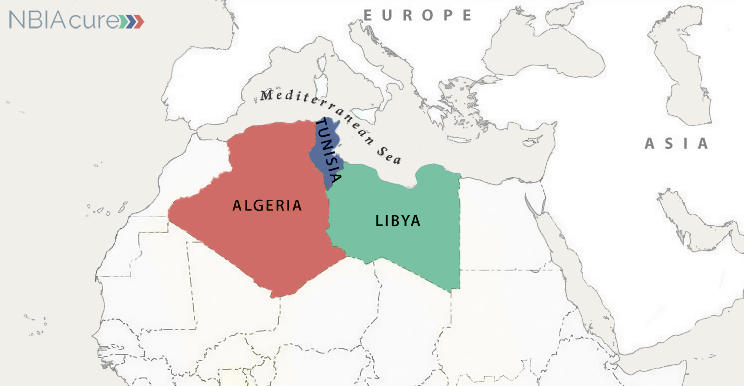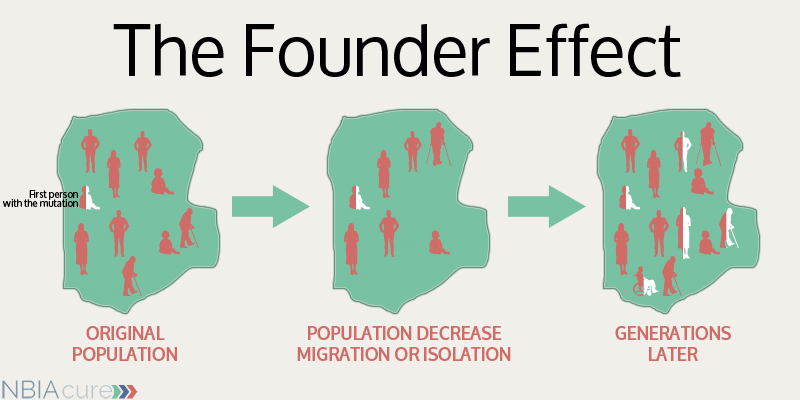NBIA in Africa? We don’t often hear about new NBIA diagnoses in African countries. The NBIA disorders are not isolated to a particular race or ethnicity so we know individuals must be diagnosed in countries all over the world. Genetic testing is more widely used each year but having affordable access to it is still a barrier in many parts of the world. There are likely many individuals with NBIA in African countries who are still undiagnosed. Another reason we don’t hear as often about these individuals is that identified cases may not be getting published and shared with the global community. That is just one reason why this new study out of North Africa is so fascinating!
PLAN Testing in North Africa
In a study by Romani et al. (2015), seventeen patients (10 girls and 7 boys) from 13 unrelated families had genetic testing of the PLA2G6 gene. This testing was done because the children were all suspected of having infantile-onset PLAN (PLA2G6-associated neurodegeneration) due to their symptoms. The PLA2G6 gene is currently the only gene known to cause all the types of PLAN. The seventeen patients came from eleven families in Tunisia, one from Algeria and one from Libya. As the map below shows, these countries are located next to each other along the southern border of the Mediterranean Sea.

After completing genetic testing, the researchers discovered that five of the families from Tunisia and one family from Libya had the exact same mutation (p.V691del) in the PLA2G6 gene. By analyzing the size and location of the mutation and the number of families sharing the mutation, the study team estimated that this genetic change first occurred in a distant relative shared by these families at least 12 generations back! Assuming that women in each generation had children around 25-30 years of age, this common ancestor likely lived around the late seventeenth century (or even earlier).
In the case of many other genetic diseases, individuals who are affected may pass away before reproducing and this stops the mutation from reaching future generations. However, in the case of autosomal recessive conditions, like PLAN, individuals with just one mutation have no symptoms and that mutation can be passed through multiple generations without any individuals being affected. It is only when two individuals with mutations (the same mutation or different mutations) in the same gene have children together that an affected individual may first appear in the family.
Based on these facts, the study speculated that the one common ancestor of all these families, who lived somewhere around the Mediterranean Sea in the late seventeenth century, was the first to spontaneously develop the p.V691del mutation in their PLA2G6 gene and then passed it on to his/her children, who then passed it on to their own children, and so forth. This phenomenon is called a “founder mutation.”
What is a founder mutation?
It is a gene mutation that is observed with high frequency in a group that is or was geographically or culturally isolated, in which one or more of the ancestors was the first carrier of that mutation.
How do founder mutations occur?

In many cultures, especially in the older generations, marriage practices such as consanguinity and endogamy increased the prevalence of founder mutations in certain populations. Consanguinity is the practice of marrying within a family, such as first or second cousins getting married. Endogamy is the practice of marrying within a specific ethnic group, religion, class, or social group. These practices, along with population decrease, migration or geographical isolation, can increase the number of individuals within a population who carry (and pass on) the same founder mutation. In the case of the Tunisian and Libyan families with the same PLAN mutation, so many years had passed since the founder mutation first occurred that many of them had no idea they were related! After all, not many of us know our ancestry going back over four hundred years ago.
How common are founder mutations?
Founder mutations are actually fairly common among humans. There are many communities around the world in which multiple disease-causing founder mutations have been identified. Some well known examples include the Amish, French-Canadian and Ashkenazi Jewish. These communities have a high rate of founder mutations because they were established by a limited number of founders and tend to marry within their community.
Summary
The families in the 2015 study by the Romani et al., had genetic testing done to try to figure out the cause of their children’s symptoms. They never could have imagined the other surprising discovery made about their shared ancestry through this testing! Interestingly, the p.V691del in the PLA2G6 gene has also previously been identified in a family from Jordan and two families from Israel. Just how far does this family tree expand?
References
Source article: “Infantile and childhood onset PLA2G6-associated neurodegeneration in a large North African cohort” by Romani et al. (2015).
Original map source: http://www.mapsofworld.com